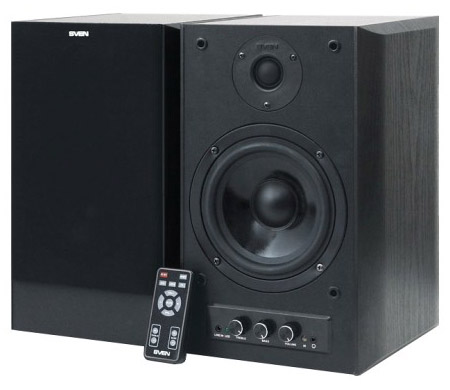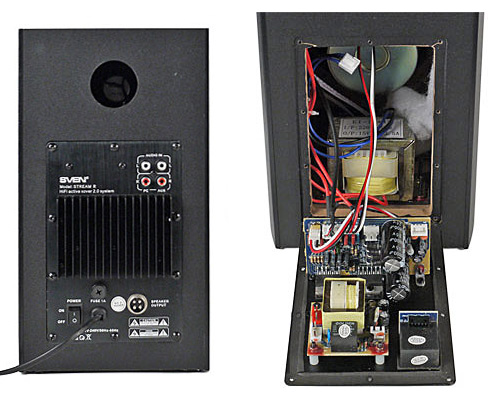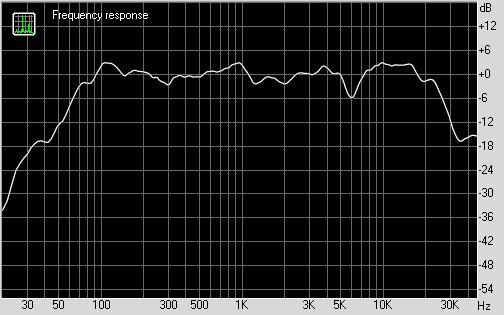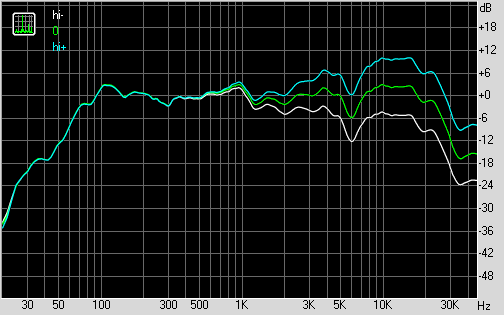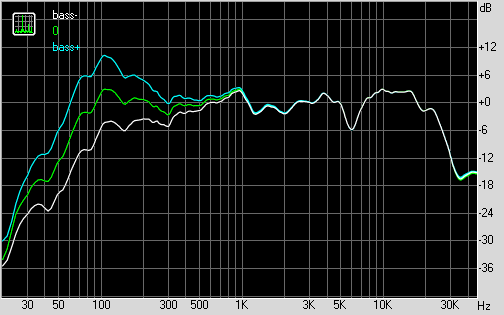This model is a much smaller appreciably (and just as much cheaper) copy of the SVEN Stream Mega R speaker system. It must be noted that the decrease of both dimensions and the price has not affected its implementation.
Functionality
Speakers are supplied with two color versions of side walls: they are made in imitation ebony and cherry. Other surfaces are black with light shagreen. There is a control panel with controls and additional jacks at the active speaker bottom; the glossy plastic of the panel and silver rims of knobs impart a little elegance, but the passive speaker on this background looks a little bit dim.
Legs are rubber round objects 3 mm thick, which we have already seen many a time. A phase inverter with a port on the rear side makes the acoustic appearance.
A removable decorative panel is rather more substantial: it is not a simple framework, but rather a MDF plate with round holes for loudspeakers covered with soft cloth. It is fixed with the help of clips in the form of balls on thin legs, which fix well.
Both loudspeakers have six Ohm, LF/squawker has a cone 12 cm in diameter, and the tweeter has one inch cloth dome. Attaching points of loudspeakers are equipped with packing seals.
Main differences from other models under review consist in the circuit technology. First and foremost, it is the bi-amping, i.e. separate amplifiers for LF and HF channels, signals for which are supplied from the active four-order filter. But such a connection method of loudspeakers will not allow being limited to two wires to connect passive speakers; that is why 4-contact XLR jacks and the 4-wire cable are used.
Power amplifiers are executed on two double integral TDA7265 low-frequency amplifiers, for cooling of which the metallic cut cover in the active speaker rear side with an additional ribbed radiator is used; the cover fixation point is equipped with the packing seal. There is also a rectifier with two 6800 μF condensers on one board with the low-frequency amplifiers, voltage to the condensers is supplied from a LF transformer with E-shaped plates (2×15 V, 3.5 A), which is fixed on the speaker bottom with the use of an absorbing gasket. Its primary winding circuit includes a fuse accessible from outside.
There is also another transformer of the same design, but with much less power – it provides 8 V 0.2 A only. It is located on a separate board and is used for power supply to low-current circuits (via a separate rectifier and integral voltage regulators on the same board), but with the help of a relay located at the same place it provides the Standby mode.
Commutating and regulation circuits are located on the third board, which is fixed on the inside of the control panel. The volume and of LF/HF timbre are controlled with jog wheels. There are two mini-jack jacks on the control panel for the headphones and an additional input, which provide a possibility to connect different devices, foremost mobile, conveniently and operatively. There is a LED indicator as well, its constant glow testifies that speakers are switched on, but constant or brief blinking testifies about Standby/Mute modes or that a remote control command has been accepted.
The remote control is the same as in SVEN Stream Mega R, which has gladdened us very much: perhaps, it is the best remote control not only among speaker systems under review, but also among more expensive systems. It has a comfortable shape and soft-touch coating, as well as ergonomically located buttons with well chosen pressing force and clear response, but its main advantage is the wide range of functions. With the help of the remote control you can regulate not only the volume and timbre, but the stereo balance as well, to switch over inputs, to control Mute and Standby modes (you can leave the last mode, by the way, not only with the help of the remote control: it is sufficient to turn any knob on the control panel).
The only, but substantial shortcoming is the same that in a senior model, i.e. small sensitiveness of the IR-sensor, due to which you have to direct the remote control to its side. The remote control is powered from CR2025 battery.
There are three cables in the package: 2.5 meter cable to connect the passive speaker, two signal 2×RCA–2×RCA cables and one 2×RCA–mini-jack 1.45 m long.
Advantages:
- bi-amping with the frequency channel separation by the active four-order filter;
- Standby mode;
- handy and multifunction remote control;
- three inputs, one of which is located on the front control panel;
- amplifier for headphones with a jack on the control panel;
- the most powerful power supply transformer among transformer having been reviewed;
- the absence of clicks during turning-on/off with the mechanical toggle switch (though, you can hear a click of the relay during switching to/from Standby mode).
Measurements in RMAA
The amplitude-frequency characteristic diagram of the SVEN Stream R speaker having been measured in the middle position of timbre controls:
The amplitude-frequency characteristic diagrams of the SVEN Stream R speaker having been measured in different positions of HF controls:
The amplitude-frequency characteristic diagrams of the SVEN Stream R speaker having been measured in different positions of LF controls:
Judging from our measurements, with the unevenness ±6 dB the working range of SVEN Stream R makes 60 Hz – 25 kHz. The amplitude-frequency characteristic diagram has an ascent and dips; however it presents a moderately smooth line.
High frequencies are controlled in the range of ±8 dB, low frequencies – in the range of ±6 dB. Measurement results of the amplitude-frequency characteristic must be taken as normal and typical for speaker systems of the same class.
Sounding
There are no evident shortcomings in the sounding of SVEN Stream R. If it is estimated by the absolute scale, it should be noted its general weak detail.
An advantage of Stream R is the balanced sounding within the whole operating range.

